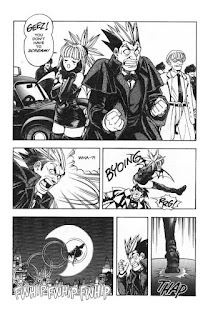My
application of the “killing stroke” trope to the combative mode
may serve me in formulating an answer to one long and nagging
theoretical problem: that of combative characters who are not overtly
challenged by most of their opponents.
In THE SAD STORY OF SUPERHERO SADISM I mentioned that during the Golden Age characters like
Superman and the Spectre (both, as all sagacious fans know, linked by
the authorship of Jerry Siegel) only occasionally encountered
opponents who could fight them in terms of “give-and-take”
combat. Even other powerhouses of the period were given convenient
vulnerabilities so that they could be placed into peril—said
vulnerabilities ranging from a special weakness, like Green Lantern’s
inability to influence wood, or something more generic, wherein a
super-strong character like Wonder Woman could be downed by a blow to
the back of her skull. At the time, my main rationale for still
deeming Golden Age Superman and Spectre as combative heroes was that,
even though their individual gangland-foes were no challenge, Crime
as a Whole was a constant menace not to the heroes but to law-abiding
innocents.
Now,
as per my Cyclopean example, the “killing stroke” usually
represents a weaker character’s attempt to marshal both skill and
strength to overcome a more powerful enemy, usually in some
appropriate way (a one-eyed monster is made to lose his only means of
seeing his prey). But it’s occurred to me that if one reverses the
valences of power in the killing-stroke paradigm, what one has is
akin to “the curse of the gods.” Greek mythology in particular is
replete with numerous stories of gods who strike impious mortals with
curses that fit those mortals’ impieties. Lycurgus the reaper is
made to reap his own kindred, Pentheus the foe of Dionysus ends up
meeting being ripped apart by Dionysian maidens, and so on.
Again,
while both of Siegel’s co-creations would have many fully combative
adventures during and after the Silver Age, it’s important to point
out that their combative status in the Golden Age doesn’t depend on
the trope of the “back-and-forth” fight. Instead, Superman and
the Spectre depend on a trope I choose to term “the reverse killing
stroke.” In contrast to a relatively weak character who slays a
more powerful entity via strategy, the practitioner of the “reverse
killing stroke” is, like a Greek god, far more powerful than any of
the mortals he blights. But, for the extrinsic sake of the story,
this godlike hero can’t just destroy his criminal targets any old
way. The superhero-god must use his power strategically, for the
sake of imposing a divine irony upon the victim.
The
second part of Superman’s debut story, retitled “the Coming ofSuperman,” shows the hero acting the part of a trickster-god. Once
Superman ferrets out the identity of a nasty munitions-maker,
obviously the Kryptonian could destroy or imprison the villain in any
number of ways. But in order to make a good story, Superman badgers
the fellow into joining the U.S, armed forces—at which
point he’s forced to face the real-life conditions of the wars he’s
fostered. To be sure, the hero allows this villain the chance to
reform, but in other contemporaneous stories, the Man of Steel uses
his power judiciously, in order to make the enemies of law and order
destroy themselves.
The
Spectre presents a more bald-faced evocation of the “wrath of God”
motif, which may be one reason the character wasn’t especially
popular in the Golden Age (nor have any subsequent treatments scored
that well, with or without the emphasis on said wrath). Siegel didn’t
seem to exploit the idea of the “reverse killing stroke” quite as
artfully as he did in Superman, but there’s a little use of irony
in the origin-story. After Jim Corrigan is slain by gangster Gat
Benson and his two cronies, the heroic cop rises from the dead,
empowered by the power of Heaven to war on crime. Not yet donning his
crimefighting togs, Corrigan overtakes his murderers, and the first
one to meet Corrigan’s gaze instantly dies. Not much irony there.
Yet the second death is more accomplished. When the second thug fails
to kill Corrigan with bullets, he unwisely tries to grapple with the
dead policeman. He pays for this “impiety,” since touching
Corrigan causes the thug’s flesh to dissolve, making him into a
living skeleton for a few macabre seconds, before Corrigan decisively
slays him. Curiously, the gang-leader Benson is spared, as Corrigan
merely allows him to fall unconscious and to be arrested. In
subsequent stories, some of the Spectre’s killing strokes had an
ironic appeal, and others were nothing special. Arguably the Bronze
Age series by Fleischer and Aparo exploited the gruesome potential of
the concept to greater effect, in that the Ghostly Guardian
consistently devised dooms for dastardly villains that would have fit
the EC horror-anthologies.
So,
can one call any aspect of these godlike punishments “self-mastery?”
Certainly such “reverse killing strokes” don’t engage one’s
sympathies in the same way as the normative killing-stroke.
Nevertheless, Superman and the Spectre must be judicious in order to
destroy evildoers in an ironically meaningful way, and this ties in
with my general concept that self-mastery entails a form of
self-limitation. Thus the killing strokes used by these heroes to
deter criminals can be deemed a special form of strategy-combat, and
thus qualify for the combative mode even without a lot of
back-and-forth battles.




























